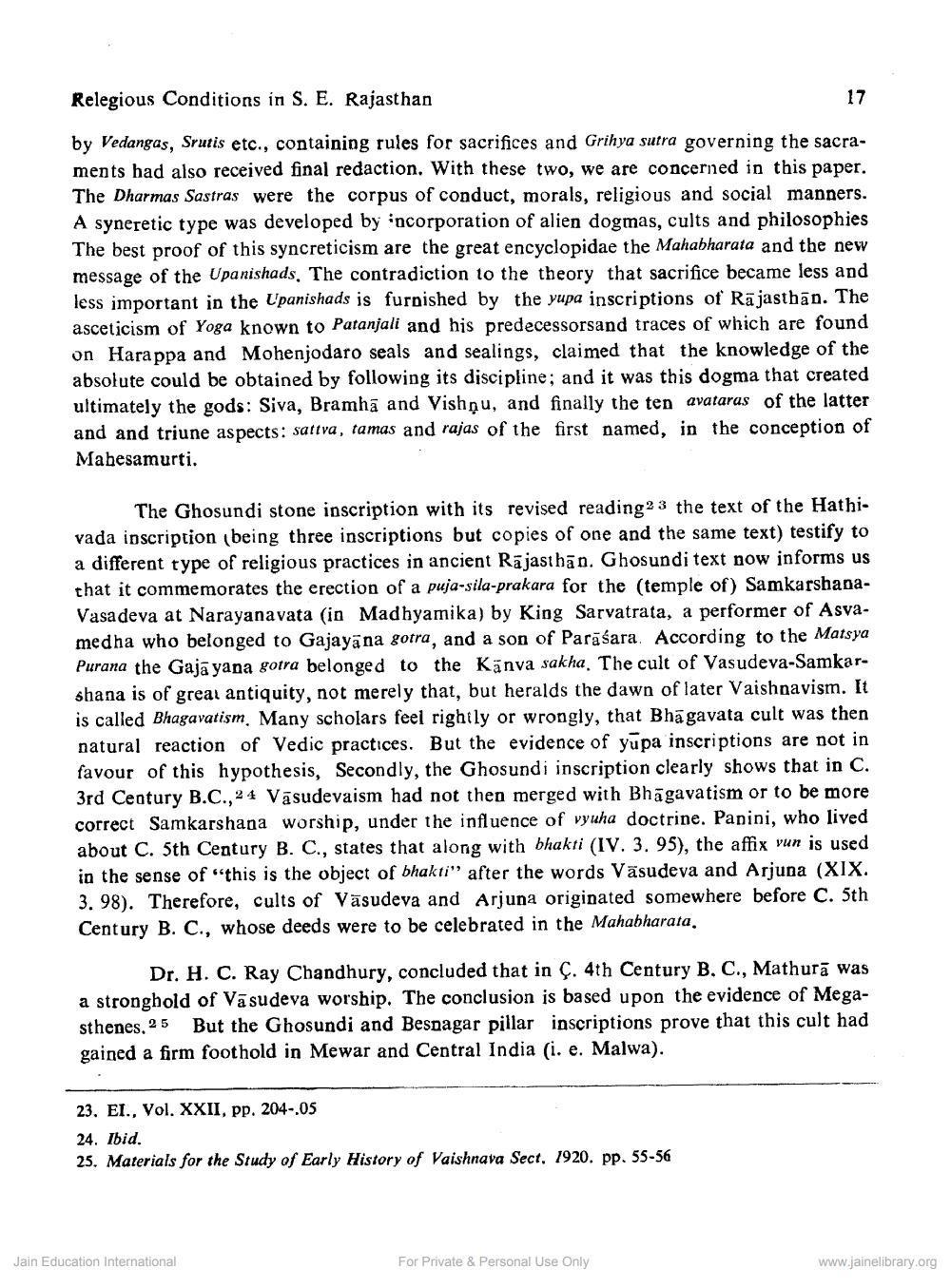________________
Relegious Conditions in S. E. Rajasthan
by Vedangas, Srutis etc., containing rules for sacrifices and Grihya sutra governing the sacraments had also received final redaction. With these two, we are concerned in this paper. The Dharmas Sastras were the corpus of conduct, morals, religious and social manners. A syneretic type was developed by incorporation of alien dogmas, cults and philosophies The best proof of this syncreticism are the great encyclopidae the Mahabharata and the new message of the Upanishads. The contradiction to the theory that sacrifice became less and less important in the Upanishads is furnished by the yupa inscriptions of Rajasthan. The asceticism of Yoga known to Patanjali and his predecessorsand traces of which are found on Harappa and Mohenjodaro seals and sealings, claimed that the knowledge of the absolute could be obtained by following its discipline; and it was this dogma that created ultimately the gods: Siva, Bramha and Vishņu, and finally the ten avataras of the latter and and triune aspects: sattva, tamas and rajas of the first named, in the conception of Mabesamurti.
The Ghosundi stone inscription with its revised reading23 the text of the Hathivada inscription (being three inscriptions but copies of one and the same text) testify to a different type of religious practices in ancient Rajasthān. Ghosundi text now informs us that it commemorates the erection of a puja-sila-prakara for the (temple of) SamkarshanaVasadeva at Narayanavata (in Madhyamika) by King Sarvatrata, a performer of Asvamedha who belonged to Gajayana gotra, and a son of Parāśara. According to the Matsya Purana the Gajā yana gotra belonged to the Känva sakha. The cult of Vasudeva-Samkarshana is of great antiquity, not merely that, but heralds the dawn of later Vaishnavism. It is called Bhagavatism. Many scholars feel rightly or wrongly, that Bhagavata cult was then natural reaction of Vedic practices. But the evidence of yupa inscriptions are not in favour of this hypothesis, Secondly, the Ghosundi inscription clearly shows that in C. 3rd Century B.C., 24 Vasudevaism had not then merged with Bhāgavatism or to be more correct Samkarshana worship, under the influence of vyuha doctrine. Panini, who lived about C. 5th Century B. C., states that along with bhakti (IV. 3. 95), the affix vun is used in the sense of "this is the object of bhakti" after the words Vāsudeva and Arjuna (XIX. 3. 98). Therefore, cults of Vāsudeva and Arjuna originated somewhere before C. 5th Century B. C., whose deeds were to be celebrated in the Mahabharata.
Dr. H. C. Ray Chandhury, concluded that in Ç. 4th Century B. C., Mathurā was a stronghold of Vasudeva worship. The conclusion is based upon the evidence of Megasthenes. 25 But the Ghosundi and Besnagar pillar inscriptions prove that this cult had gained a firm foothold in Mewar and Central India (i. e. Malwa).
23. EI., Vol. XXII, pp. 204-.05 24. Ibid. 25. Materials for the Study of Early History of Vaishnava Sect. 1920. pp. 55-56
Jain Education International
For Private & Personal Use Only
www.jainelibrary.org




